药学英语第五版第三单元
- 格式:docx
- 大小:16.52 KB
- 文档页数:5
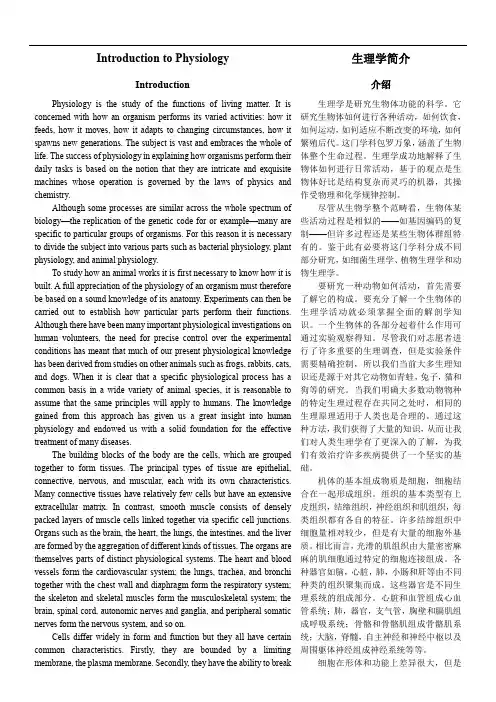
Introduction to PhysiologyIntroductionPhysiology is the study of the functions of living matter. It is concerned with how an organism performs its varied activities: how it feeds, how it moves, how it adapts to changing circumstances, how it spawns new generations. The subject is vast and embraces the whole of life. The success of physiology in explaining how organisms perform their daily tasks is based on the notion that they are intricate and exquisite machines whose operation is governed by the laws of physics and chemistry.Although some processes are similar across the whole spectrum of biology—the replication of the genetic code for or example—many are specific to particular groups of organisms. For this reason it is necessary to divide the subject into various parts such as bacterial physiology, plant physiology, and animal physiology.To study how an animal works it is first necessary to know how it is built. A full appreciation of the physiology of an organism must therefore be based on a sound knowledge of its anatomy. Experiments can then be carried out to establish how particular parts perform their functions. Although there have been many important physiological investigations on human volunteers, the need for precise control over the experimental conditions has meant that much of our present physiological knowledge has been derived from studies on other animals such as frogs, rabbits, cats, and dogs. When it is clear that a specific physiological process has a common basis in a wide variety of animal species, it is reasonable to assume that the same principles will apply to humans. The knowledge gained from this approach has given us a great insight into human physiology and endowed us with a solid foundation for the effective treatment of many diseases.The building blocks of the body are the cells, which are grouped together to form tissues. The principal types of tissue are epithelial, connective, nervous, and muscular, each with its own characteristics. Many connective tissues have relatively few cells but have an extensive extracellular matrix. In contrast, smooth muscle consists of densely packed layers of muscle cells linked together via specific cell junctions. Organs such as the brain, the heart, the lungs, the intestines, and the liver are formed by the aggregation of different kinds of tissues. The organs are themselves parts of distinct physiological systems. The heart and blood vessels form the cardiovascular system; the lungs, trachea, and bronchi together with the chest wall and diaphragm form the respiratory system; the skeleton and skeletal muscles form the musculoskeletal system; the brain, spinal cord, autonomic nerves and ganglia, and peripheral somatic nerves form the nervous system, and so on.Cells differ widely in form and function but they all have certain common characteristics. Firstly, they are bounded by a limiting membrane, the plasma membrane. Secondly, they have the ability to break生理学简介介绍生理学是研究生物体功能的科学。
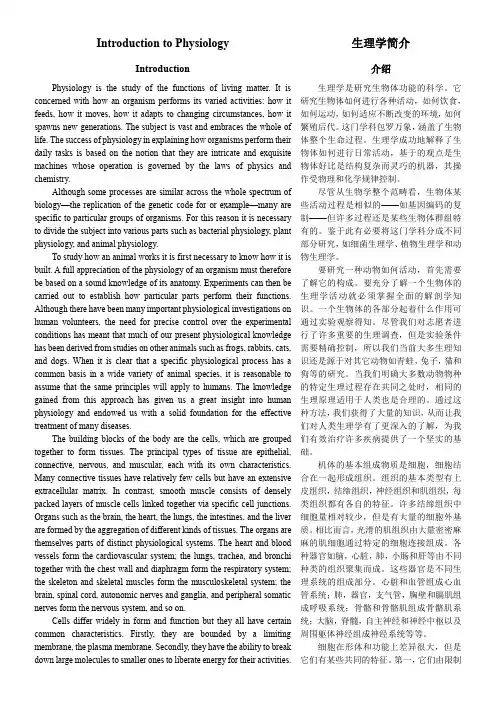
Introduction to PhysiologyIntroductionPhysiology is the study of the functions of living matter. It is concerned with how an organism performs its varied activities: how it feeds, how it moves, how it adapts to changing circumstances, how it spawns new generations. The subject is vast and embraces the whole of life. The success of physiology in explaining how organisms perform their daily tasks is based on the notion that they are intricate and exquisite machines whose operation is governed by the laws of physics and chemistry.Although some processes are similar across the whole spectrum of biology—the replication of the genetic code for or example—many are specific to particular groups of organisms. For this reason it is necessary to divide the subject into various parts such as bacterial physiology, plant physiology, and animal physiology.To study how an animal works it is first necessary to know how it is built. A full appreciation of the physiology of an organism must therefore be based on a sound knowledge of its anatomy. Experiments can then be carried out to establish how particular parts perform their functions. Although there have been many important physiological investigations on human volunteers, the need for precise control over the experimental conditions has meant that much of our present physiological knowledge has been derived from studies on other animals such as frogs, rabbits, cats, and dogs. When it is clear that a specific physiological process has a common basis in a wide variety of animal species, it is reasonable to assume that the same principles will apply to humans. The knowledge gained from this approach has given us a great insight into human physiology and endowed us with a solid foundation for the effective treatment of many diseases.The building blocks of the body are the cells, which are grouped together to form tissues. The principal types of tissue are epithelial, connective, nervous, and muscular, each with its own characteristics. Many connective tissues have relatively few cells but have an extensive extracellular matrix. In contrast, smooth muscle consists of densely packed layers of muscle cells linked together via specific cell junctions. Organs such as the brain, the heart, the lungs, the intestines, and the liver are formed by the aggregation of different kinds of tissues. The organs are themselves parts of distinct physiological systems. The heart and blood vessels form the cardiovascular system; the lungs, trachea, and bronchi together with the chest wall and diaphragm form the respiratory system; the skeleton and skeletal muscles form the musculoskeletal system; the brain, spinal cord, autonomic nerves and ganglia, and peripheral somatic nerves form the nervous system, and so on.Cells differ widely in form and function but they all have certain common characteristics. Firstly, they are bounded by a limiting membrane, the plasma membrane. Secondly, they have the ability to break down large molecules to smaller ones to liberate energy for their activities.生理学简介介绍生理学是研究生物体功能的科学。
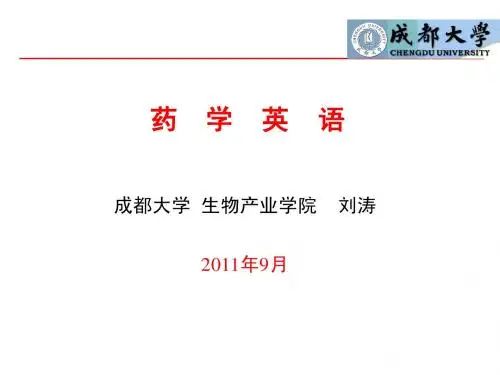
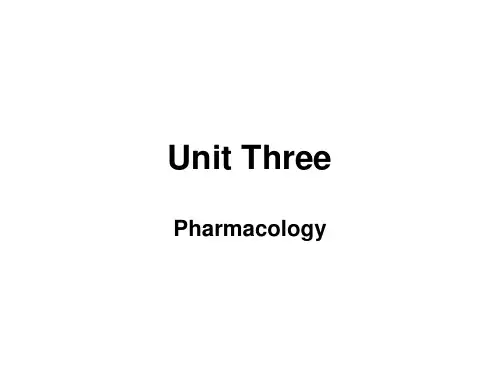
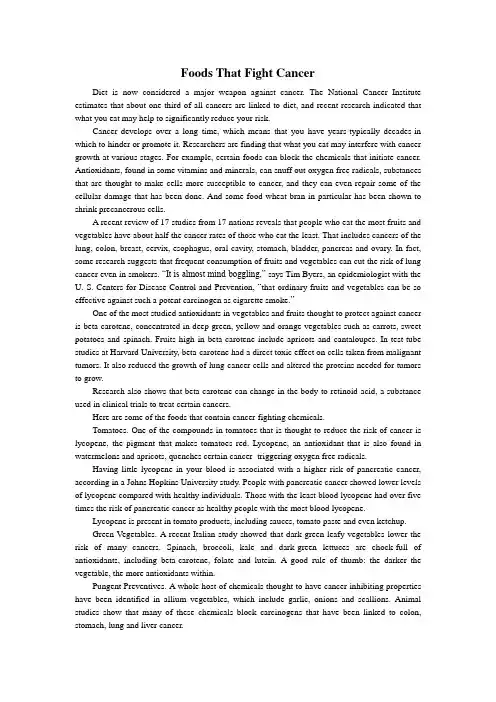
Foods That Fight CancerDiet is now considered a major weapon against cancer. The National Cancer Institute estimates that about one-third of all cancers are linked to diet, and recent research indicated that what you eat may help to significantly reduce your risk.Cancer develops over a long time, which means that you have years-typically decades-in which to hinder or promote it. Researchers are finding that what you eat may interfere with cancer growth at various stages. For example, certain foods can block the chemicals that initiate cancer. Antioxidants, found in some vitamins and minerals, can snuff out oxygen free radicals, substances that are thought to make cells more susceptible to cancer, and they can even repair some of the cellular damage that has been done. And some food-wheat bran in particular-has been shown to shrink precancerous cells.A recent review of 17 studies from 17 nations reveals that people who eat the most fruits and vegetables have about half the cancer rates of those who eat the least. That includes cancers of the lung, colon, breast, cervix, esophagus, oral cavity, stomach, bladder, pancreas and ovary. In fact, some research suggests that frequent consumption of fruits and vegetables can cut the risk of lung cancer even in smokers. “It is almost mind-boggling,” says Tim Byers, an epidemiologist with the U. S. Centers for Disease Control and Prevention, “that ordinary fruits and vegetables can be so effective against such a potent carcinogen as cigarette smoke.”One of the most studied antioxidants in vegetables and fruits thought to protect against cancer is beta-carotene, concentrated in deep green, yellow and orange vegetables such as carrots, sweet potatoes and spinach. Fruits high in beta-carotene include apricots and cantaloupes. In test-tube studies at Harvard University, beta-carotene had a direct toxic effect on cells taken from malignant tumors. It also reduced the growth of lung-cancer cells and altered the proteins needed for tumors to grow.Research also shows that beta-carotene can change in the body to retinoid acid, a substance used in clinical trials to treat certain cancers.Here are some of the foods that contain cancer-fighting chemicals.Tomatoes. One of the compounds in tomatoes that is thought to reduce the risk of cancer is lycopene, the pigment that makes tomatoes red. Lycopene, an antioxidant that is also found in watermelons and apricots, quenches certain cancer- triggering oxygen free radicals.Having little lycopene in your blood is associated with a higher risk of pancreatic cancer, according in a Johns Hopkins University study. People with pancreatic cancer showed lower levels of lycopene compared with healthy individuals. Those with the least blood lycopene had over five times the risk of pancreatic cancer as healthy people with the most blood lycopene.Lycopene is present in tomato products, including sauces, tomato paste and even ketchup.Green Vegetables. A recent Italian study showed that dark-green leafy vegetables lower the risk of many cancers. Spinach, broccoli, kale and dark-green lettuces are chock-full of antioxidants, including beta-carotene, folate and lutein. A good rule of thumb: the darker the vegetable, the more antioxidants within.Pungent Preventives. A whole host of chemicals thought to have cancer-inhibiting properties have been identified in allium vegetables, which include garlic, onions and scallions. Animal studies show that many of these chemicals block carcinogens that have been linked to colon, stomach, lung and liver cancer.A study at Pennsylvania State University found that feeding rats various garlic extracts and preparations reduced mammary tumors by as much as 71 percent. In humans, studies suggest that those who eat more onion and garlic are less prone to gastrointestinal cancer.Research suggests that garlic compounds may even interfere with cancer progression. A recent German study found that ajoene, a garlic compound, is toxic to malignant cells. Garlic may also antagonize existing cancer by boosting immune functions, according to researchers at Loma Linda University School of Medicine. Their study, done on mice, found that garlic’s sulfur compounds increased the activity of macrophages and T-lymphocytes, two of the components of the immune system that destroy tumor cells.Citrus Fruit. “Eat oranges, grapefruits, lemons and limes as often as possible,”says toxicologist Herbert Pierson, a former project officer with the National Cancer Institute. He calls citrus fruit an all-around cancer package because it possesses every class of natural substances (carotenoids, flavonoids and others) that individually have neutralized powerful chemical carcinogens in animals.Citrus fruit may be particularly effective in reducing the risk of pancreatic cancer. One study found that in a group of Swedes, those who ate a citrus fruit almost daily reduced the risk of pancreatic cancer by one-half to more than two-thirds, as compared with eating citrus fruit less than once a week.Cruciferous Vegetables. Cruciferous vegetables, such as cabbage, cauliflower, Brussels sprouts, broccoli, kale, mustard greens and turnips, may reduce the risk of breast cancer. In fact, researchers at Eppley Institute for Research in Cancer and Allied diseases at the University of Nebraska at Omaha found that feeding animals cabbage and collard greens (also a cruciferous vegetable), along with a low-fat diet, reduced the incidence of mammary cancers. Eat cruciferous vegetables raw or lightly cooked. Overcooking may destroy the indoles, compounds found in these vegetables that may protect against cancer.Cruciferous vegetables may also work to head off stomach and colon cancer. Research conducted in Utah revealed that men who ate the most cruciferous vegetables had a 70 percent lower risk of colon cancer than those who ate the least of such vegetables.Soybeans. Soybeans contain at least five compounds believed to inhibit cancer. In fact, one of the compounds is chemically similar to the drug tamoxifen, which is routinely used to treat estrogen-dependent breast cancer and is now being tested in a large clinical trial to see if it can prevent the disease. In animal studies, soybean constituents have been found to block colon, skin and other cancers by possibly slowing the growth and division of cancer cells.Dried and canned beans-chickpeas, lentils, kidney, pinto, navy, black, pink and white-contain possible anti-cancer agents as well - A study of Seventh-day Adventists in California showed that those who ate beans weekly were 40 percent less likely to die of pancreatic cancer than those who ate them less than once a week.Wheat Bran. Wheat bran may lower the risk of colon cancer. A double-blind study of patients at The New York Hospital-Cornell Medical Center found that two one-ounce servings of wheat bran cereal a day caused premalignant colon polyps to shrink within six months. Most remarkable, say researchers, is that such a small amount of food could have such an impact within a short period of time, illustrating that dietary intervention may work even after precancerous warning signs have appeared.Low-Fat Milk. While the saturated fat in milk seems to promote certain cancers, anothersubstance in milk may deter them. Researchers at Roswell Park Cancer Institute in Buffalo, N. Y., discovered, not surprisingly, that drinkers of whole milk had higher odds than non-milk-drinkers of developing cancers of the oral cavity, stomach, colon, rectum, lung, bladder, breast and cervix. But they also found that those drinking low-fat milk were less likely than non-milk-drinkers to develop cancers of the oral cavity, stomach, rectum and cervix. Why? Scientists suspect that elements such as calcium, riboflavin, or vitamins A, C, and D (present in whole milk, too, but apparently less effective) may act as anti-cancer agents in ways not yet understood.To get the most cancer-protective compounds from your diet, strive for five or more servings of fruits and vegetables daily, advises the National Cancer Institute. One serving means one-half cup of most cooked or raw fruits or vegetables, one cup of raw leafy vegetables, one medium piece of fresh fruit, or six ounces of fruit juice or vegetable juice. The ideal diet is low in fat and calories, high in fiber, and it includes a variety of nutrient-rich foods such as fruits, vegetables, whole grains, beans, seeds, nuts and, if desired, low-fat animal proteins.。
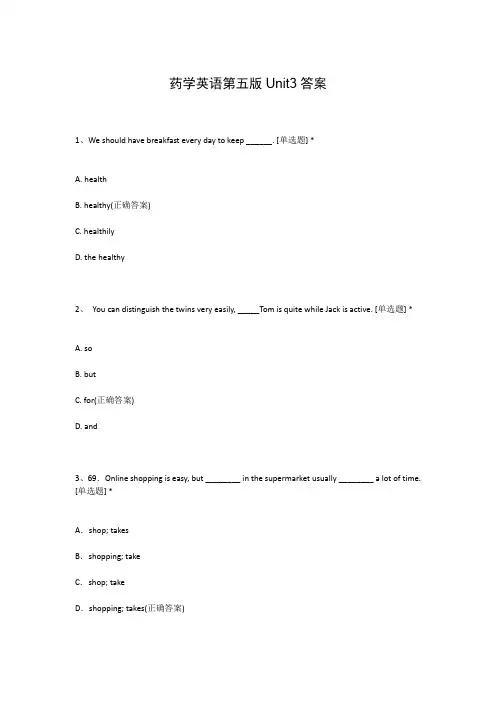
药学英语第五版Unit3答案1、We should have breakfast every day to keep ______. [单选题] *A. healthB. healthy(正确答案)C. healthilyD. the healthy2、You can distinguish the twins very easily, _____Tom is quite while Jack is active. [单选题] *A. soB. butC. for(正确答案)D. and3、69.Online shopping is easy, but ________ in the supermarket usually ________ a lot of time. [单选题] *A.shop; takesB.shopping; takeC.shop; takeD.shopping; takes(正确答案)4、As for the quality of this model of color TV sets, the ones made in Chine are by no means _____ those imported. [单选题] *A inferior thanB less inferior toC less inferior thanD. inferior to(正确答案)5、We should _______ a hotel before we travel. [单选题] *A. book(正确答案)B. liveC. stayD. have6、The red jacket is _______ than the green one. [单选题] *A. cheapB. cheapestC. cheaper(正确答案)D. more cheap7、Let us put the matter to the vote,()? [单选题] *B. can weC. may ID. shall we(正确答案)8、I’ve got some very _______ news to tell you. [单选题] *A. exciting(正确答案)B. comfortableC. convenientD. beautiful9、Look! There are some boats ______ the river.()[单选题] *A. on(正确答案)B. overC. betweenD. in10、3.—Will you buy the black car?No, I won't. I will buya(n) ________ one because I don't have enough money. [单选题] *A.cheap(正确答案)B.expensiveD.low11、—_____ are the Olympic Games held? —Every four years [单选题] *A. How longB. How often(正确答案)C. How soonD. How far12、He gathered his courage and went on writing music. [单选题] *A. 从事B. 靠······谋生C. 继续(正确答案)D. 致力于13、--Jenny, what’s your favorite _______?? ? ? --like peaches best. [单选题] *A. fruit(正确答案)B. vegetablesC. drinkD. plants14、There is something wrong with my teeth. I’ve had?a _______. [单选题] *A. toothache(正确答案)B. headacheC. stomachacheD. heartache15、_______ a busy afternoon! [单选题] *A. HowB. What(正确答案)C. WhichD. Wish16、With all the work on hand, he _____ to the cinema last night. [单选题] *A.should goB.must have goneC.might goD..shouldn’t have gone(正确答案)17、Nuclear science should be developed to benefit the people_____harm them. [单选题] *A.more thanB.other thanC.rather than(正确答案)D.better than18、Mike and his friend are going to the _______ to see the new action movie tonight. [单选题] *A. book shopB. restaurantC. concertD. cinema(正确答案)19、She was seen _____ that theatre just now. [单选题] *A. enteredB. enterC. to enter(正确答案)D. to be entering20、_____ Lucy _____ Lily has joined the swimming club because they have no time. [单选题] *A. Not only; but alsoB. Neither; nor(正确答案)C. Either; orD. Both; and21、25.A watch is important in our life. It is used for ______ the time. [单选题] * A.telling (正确答案)B.sayingC.speakingD.holding22、--What are you going to be in the future?--I want to be _______ actor. [单选题] *A. aB. an(正确答案)C. theD. /23、She spoke with a strong Scottish()[单选题] *A. speechB. accent(正确答案)C.voiceD. sound24、In many cities, a low-carbon lifestyle has become(). [单选题] *A. more popular and more popularB. more and more popular(正确答案)C. the most popularD. most and most popular25、Many children have to _______ their parents. [单选题] *A. divide intoB. put onC. depend on(正确答案)D. take on26、This is not our house. lt belongs to _____. [单选题] *A. the Turners'B. the Turners(正确答案)C. Turner'sD. Turners27、In order to find the missing child, villagers _______ all they can over the past five hours. [单选题] *A. didB. doC. had doneD. have been doing(正确答案)28、_____ to wait for hours,she brought along a book to read. [单选题] *A. ExpectedB. Expecting(正确答案)C. ExpectsD. To expect29、As soon as he _______, he _______ to his family. [单选题] *A. arrived, writesB. arrived, writtenC. arrived, wrote(正确答案)D. arrives, write30、He couldn’t ______ the maths problem without your help. [单选题] *A. work out(正确答案)B. work atC. work forD. work with。

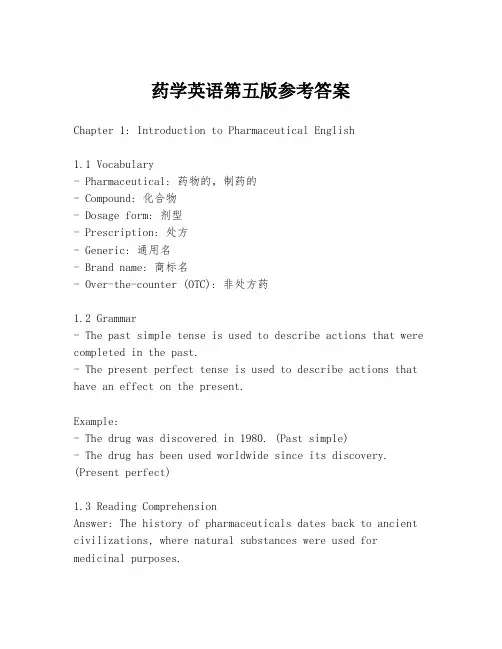
药学英语第五版参考答案Chapter 1: Introduction to Pharmaceutical English1.1 Vocabulary- Pharmaceutical: 药物的,制药的- Compound: 化合物- Dosage form: 剂型- Prescription: 处方- Generic: 通用名- Brand name: 商标名- Over-the-counter (OTC): 非处方药1.2 Grammar- The past simple tense is used to describe actions that were completed in the past.- The present perfect tense is used to describe actions that have an effect on the present.Example:- The drug was discovered in 1980. (Past simple)- The drug has been used worldwide since its discovery. (Present perfect)1.3 Reading ComprehensionAnswer: The history of pharmaceuticals dates back to ancient civilizations, where natural substances were used for medicinal purposes.1.4 Translation- 药物研发: Drug development- 药物副作用: Side effects of drugs- 药物相互作用: Drug interactionsChapter 2: Drug Classification and Nomenclature2.1 Vocabulary- Antimicrobial: 抗微生物的- Anti-inflammatory: 抗炎的- Analgesic: 镇痛的- Antibiotic: 抗生素- Antihistamine: 抗组胺的2.2 Grammar- The comparative form is used to compare two things.- The superlative form is used to compare three or more things.Example:- This drug is more effective than the other one. (Comparative)- This is the most effective drug among all. (Superlative)2.3 Reading ComprehensionAnswer: Antibiotics are used to treat bacterial infections, while antivirals are used for viral infections.2.4 Translation- 抗生素分类: Classification of antibiotics- 药物命名法: Drug nomenclature- 药物通用名: Generic names of drugsChapter 3: Drug Dosage and Administration3.1 Vocabulary- Dosage: 剂量- Administration: 给药- Intravenous: 静脉注射- Oral: 口服- Topical: 外用3.2 Grammar- Passive voice is used when the receiver of the action is more important than the doer.Example:- The drug is administered orally. (Passive voice)3.3 Reading ComprehensionAnswer: The dosage of a drug depends on various factors, including the patient's weight, age, and medical condition.3.4 Translation- 药物剂量计算: Calculation of drug dosage- 给药途径: Routes of drug administration- 药物剂量调整: Adjustment of drug dosageChapter 4: Drug Safety and Efficacy4.1 Vocabulary- Toxicity: 毒性- Side effect: 副作用- Efficacy: 疗效- Contraindication: 禁忌症- Adverse reaction: 不良反应4.2 Grammar- Modal verbs are used to express ability, permission, or obligation.Example:- The drug can be toxic in high doses. (Ability)- Patients must be informed about potential side effects. (Obligation)4.3 Reading ComprehensionAnswer: Drug safety is ensured through rigorous testing and monitoring of side effects and adverse reactions.4.4 Translation- 药物安全性评估: Drug safety assessment- 药物有效性研究: Research on drug efficacy- 不良药物反应报告: Reporting of adverse drug reactionsChapter 5: Drug Development and Regulatory Affairs5.1 Vocabulary- Clinical trial: 临床试验- Approval: 批准- Patent: 专利- Regulatory authority: 监管机构5.2 Grammar- Conditional sentences are used to talk about possible situations and their results.Example:- If the drug passes all clinical trials, it will be approved for use. (First conditional)5.3 Reading ComprehensionAnswer: The drug development process involves multiple stages, including preclinical research, clinical trials, andregulatory approval.5.4 Translation- 药物研发流程: Drug development process- 药品监管法规: Pharmaceutical regulatory laws- 临床试验设计: Design of clinical trialsChapter 6: Pharmaceutical Marketing and Ethics6.1 Vocabulary- Marketing: 市场营销- Ethics: 伦理- Promotion: 促销- Informed consent: 知情同意- Conflict of interest: 利益冲突6.2 Grammar- The present continuous tense is used to describe actions happening at the moment of speaking.Example:- The pharmaceutical company is promoting its new drug. (Present continuous)6.3 Reading ComprehensionAnswer: Ethical considerations in pharmaceutical marketing include transparency, informed consent, and avoiding conflicts of interest.6.4 Translation- 药品市场营销策略: Pharmaceutical marketing strategies- 医药伦理问题。
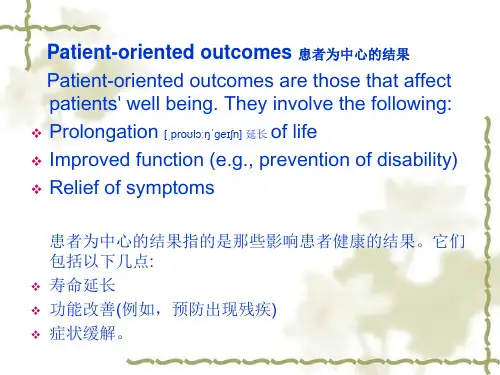
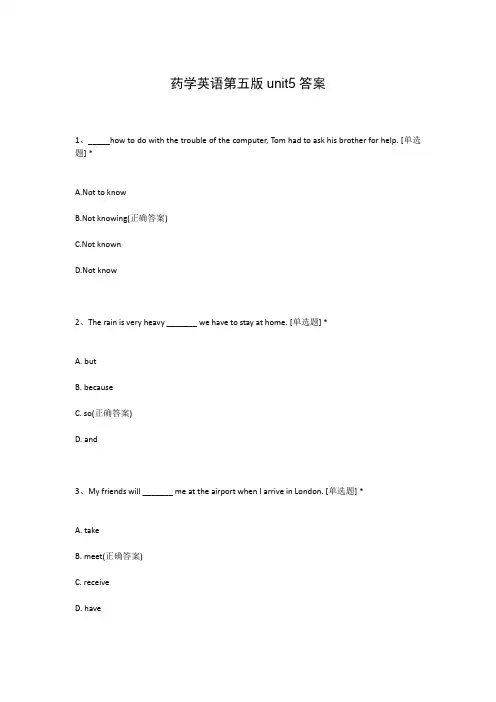
药学英语第五版unit5答案1、_____how to do with the trouble of the computer, Tom had to ask his brother for help. [单选题] *A.Not to knowB.Not knowing(正确答案)C.Not knownD.Not know2、The rain is very heavy _______ we have to stay at home. [单选题] *A. butB. becauseC. so(正确答案)D. and3、My friends will _______ me at the airport when I arrive in London. [单选题] *A. takeB. meet(正确答案)C. receiveD. have4、Will you please say it again? I _______ you. [单选题] *A. didn’t hear(正确答案)B. don’t heardC. didn’t heardD. don’t hear5、_______ win the competition, he practiced a lot. [单选题] *A. BecauseB. In order to(正确答案)C. Thanks toD. In addition to6、Bill Gates is often thought to be the richest man in the world. _____, his personal life seems not luxury. [单选题] *A. MoreoverB. ThereforeC. However(正确答案)D. Besides7、There are many_____desks in the room. [单选题] *rge old brown(正确答案)B.old large brownrge brown oldD.brown old large8、He always ______ the teacher carefully in class. [单选题] *A. listensB. listens to(正确答案)C. hearsD. hears of9、I’m _______ I must be leaving now. [单选题] *A. afraid(正确答案)B. thinkC. thoughtD. free10、Kids will soon get tired of learning _____ more than they can. [单选题] *A. if they expect to learnB. if they are expected to learn(正确答案)C. if they learn to expectD. if they are learned to expect11、He held his()when the results were read out. [单选题] *A. breath(正确答案)B. voiceC. soundD. thought12、The manager was quite satisfied with his job. [单选题] *A. 担心的B. 满意的(正确答案)C. 高兴的D. 放心的13、While they were in discussion, their manager came in by chance. [单选题] *A. 抓住时机B. 不时地C. 碰巧(正确答案)D. 及时14、--All of you have passed the test!--_______ pleasant news you have told us! [单选题] *A. HowB. How aC. What(正确答案)D. What a15、We had a party last month, and it was a lot of fun, so let's have _____ one this month. [单选题] *A.otherB.the otherC.moreD.another(正确答案)16、If people _____ overanxious about remembering something, they will forget it. [单选题] *A. will beB. would beC. wereD. are(正确答案)17、44.—Hi, Lucy. You ________ very beautiful in the new dress today.—Thank you very much. [单选题] *A.look(正确答案)B.watchC.look atD.see18、42.—________ meat do you want?—Half a kilo. [单选题] *A.How much(正确答案)B.How manyC.WhatD.Which19、—Whose book is it? Is it yours?—No, ask John. Maybe it’s ______.()[单选题] *A. hersB. his(正确答案)C. he’sD. her20、My father can?_______ a little English. [单选题] *A. speak(正确答案)B. sayC. talkD. tell21、The news is?_______. We are all _______ at it. [单选题] *A. exciting;?excited(正确答案)B. excited;?excitingC. exciting;?excitingD. excited;?excited22、He went to America last Friday. Alice came to the airport to _______ him _______. [单选题] *A. take; offB. see; off(正确答案)C. send; upD. put; away23、The manager gave one of the salesgirls an accusing look for her()attitude towards customers. [单选题] *A. impartialB. mildC. hostile(正确答案)D. opposing24、Taking the subway is quite fast and cheap. It can _______ both time and money. [单选题] *A. savesB. save(正确答案)C. earnD. use25、You needn’t _______ me. I’m old enough to take care of myself. [单选题] *A. worry about(正确答案)B. write downC. put awayD. wake up26、--_______ I borrow these magazines?--Sorry, only the magazines over there can be borrowed. [单选题] *A. MustB. WouldC. May(正确答案)D. Need27、—I can’t always get good grades. What should I do?—The more ______ you are under, the worse grades you may get. So take it easy!()[单选题] *A. wasteB. interestC. stress(正确答案)D. fairness28、The little boy saved his money ______ he could buy his mother a gift on Mother’s Day.()[单选题] *A. butB. such thatC. in order toD. so that(正确答案)29、19.Students will have computers on their desks ________ . [单选题] *A.in the future(正确答案)B.on the futureC.at the momentD.in the past30、—Can you play tennis?—______. But I can play basketball.()[单选题] *A. Yes, I canB. Yes, I doC. No. I can’t(正确答案)D. No, I don’t。
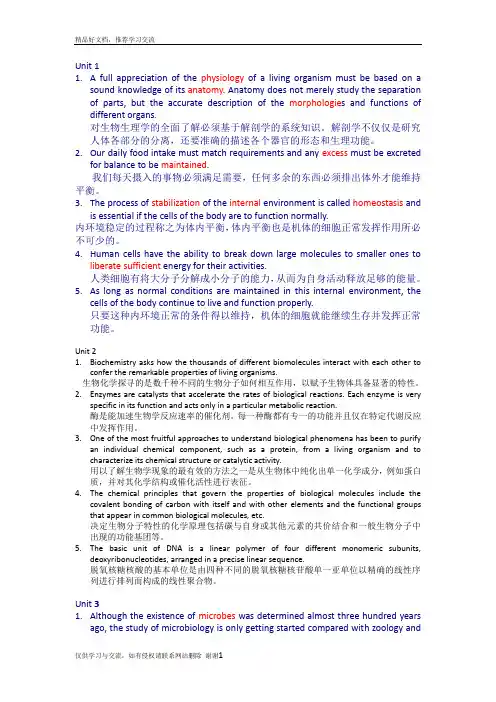
Unit 11. A full appreciation of the physiology of a living organism must be based on asound knowledge of its anatomy. Anatomy does not merely study the separation of parts, but the accurate description of the morphologie s and functions of different organs.对生物生理学的全面了解必须基于解剖学的系统知识。
解剖学不仅仅是研究人体各部分的分离,还要准确的描述各个器官的形态和生理功能。
2.Our daily food intake must match requirements and any excess must be excretedfor balance to be maintained.我们每天摄入的事物必须满足需要,任何多余的东西必须排出体外才能维持平衡。
3.The process of stabilization of the internal environment is called homeostasis andis essential if the cells of the body are to function normally.内环境稳定的过程称之为体内平衡,体内平衡也是机体的细胞正常发挥作用所必不可少的。
4.Human cells have the ability to break down large molecules to smaller ones toliberate sufficient energy for their activities.人类细胞有将大分子分解成小分子的能力,从而为自身活动释放足够的能量。
药学英语知识点总结药学英语是药学专业学生必备的重要工具之一,掌握了药学英语知识,可以更好的理解和学习相关的专业课程,也可以更好的与国外专业人员交流和合作。
以下是关于药学英语的知识点总结。
一、药物分类1. 药理学分类(1) 根据药物的作用机制:如促进、抑制、阻断等。
(2) 根据药物所作用的靶点:如受体、酶、细胞膜等。
(3) 根据药物的作用部位:如心血管系统、消化系统、免疫系统等。
2. 药物命名(1) 通用名:指国际上通用的、无专利权的药品名称。
(2) 商品名:指某个公司注册的特有的药品名称。
(3) 化学名:指药品的化学结构和化学名称。
3. 药物剂型(1) 固体剂型:如片剂、胶囊等。
(2) 液体剂型:如口服液、注射液等。
(3) 半固体剂型:如软膏、栓剂等。
二、药物制剂1. 药物制备(1) 药物合成:指通过化学反应合成所需的药物。
(2) 药物提取:指从天然植物、动物中提取所需的有效成分。
(3) 药物配制:指将已有的药物原料混合制备成药物制剂。
2. 药物质量(1) 药物纯度:指药物中有效成分所占比例的高低。
(2) 药物稳定性:指药物在不同条件下的稳定性。
(3) 药物活性:指药物对疾病的治疗效果。
三、药理学1. 药物动力学(1) 药物吸收:指药物进入生物体内的过程。
(2) 药物分布:指药物在生物体内的分布情况。
(3) 药物代谢:指药物在生物体内的代谢过程。
(4) 药物排泄:指药物从生物体内排除的过程。
2. 药理作用(1) 药性:指药物的主要作用。
(2) 药效:指药物对疾病的治疗效果。
(3) 药物不良反应:指药物使用过程中可能出现的不良反应。
3. 药物相互作用(1) 药物药物相互作用:指不同药物在体内相互作用的过程。
(2) 药物食物相互作用:指药物和食物中某些成分相互作用的过程。
(3) 药物饮酒相互作用:指药物和酒精相互作用的过程。
四、药学实验1. 药物分析(1) 药物定性分析:指确定药物中所含成分的种类。
Introduction to PhysiologyIntroductionPhysiology is the study of the functions of living matter. It is concerned with how an organism performs its varied activities: how it feeds, how it moves, how it adapts to changing circumstances, how it spawns new generations. The subject is vast and embraces the whole of life. The success of physiology in explaining how organisms perform their daily tasks is based on the notion that they are intricate and exquisite machines whose operation is governed by the laws of physics and chemistry.Although some processes are similar across the whole spectrum of biology—the replication of the genetic code for or example—many are specific to particular groups of organisms. For this reason it is necessary to divide the subject into various parts such as bacterial physiology, plant physiology, and animal physiology.To study how an animal works it is first necessary to know how it is built. A full appreciation of the physiology of an organism must therefore be based on a sound knowledge of its anatomy. Experiments can then be carried out to establish how particular parts perform their functions. Although there have been many important physiological investigations on human volunteers, the need for precise control over the experimental conditions has meant that much of our present physiological knowledge has been derived from studies on other animals such as frogs, rabbits, cats, and dogs. When it is clear that a specific physiological process has a common basis in a wide variety of animal species, it is reasonable to assume that the same principles will apply to humans. The knowledge gained from this approach has given us a great insight into human physiology and endowed us with a solid foundation for the effective treatment of many diseases.The building blocks of the body are the cells, which are grouped together to form tissues. The principal types of tissue are epithelial, connective, nervous, and muscular, each with its own characteristics. Many connective tissues have relatively few cells but have an extensive extracellular matrix. In contrast, smooth muscle consists of densely packed layers of muscle cells linked together via specific cell junctions. Organs such as the brain, the heart, the lungs, the intestines, and the liver are formed by the aggregation of different kinds of tissues. The organs are themselves parts of distinct physiological systems. The heart and blood vessels form the cardiovascular system; the lungs, trachea, and bronchi together with the chest wall and diaphragm form the respiratory system; the skeleton and skeletal muscles form the musculoskeletal system; the brain, spinal cord, autonomic nerves and ganglia, and peripheral somatic nerves form the nervous system, and so on.Cells differ widely in form and function but they all have certain common characteristics. Firstly, they are bounded by a limiting membrane, the plasma membrane. Secondly, they have the ability to break down large molecules to smaller ones to liberate energy for their activities.生理学简介介绍生理学是研究生物体功能的科学。
Biochemistry Seeks to Explain Life in Chemical TermsThe molecules of which living organisms are composed conform to all the familiar laws of chemistry, but they alsointeract with each other in accordance with another set of principles, which we shall refer to collectively as the molecularlogic of life. These principles do not involve new or yet undiscovered physical laws or forces. Instead, they are a set ofrelationships characterizing the nature, function, and interactions of biomolecules.If living organisms are composed of molecules that are intrinsically inanimate, how do these molecules confer theremarkable combination of characteristics we call life? How is it that a living organism appears to be more than the sum ofits inanimate parts? Philosophers once answered that living organisms are endowed with a mysterious and divine life force,but this doctrine (vitalism) has been firmly rejected by modern science. The basic goal of the science of biochemistry is todetermine how the collections of inanimate molecules that constitute living organisms interact with each other to maintainand perpetuate life. Although biochemistry yields important insights and practical applications in medicine, agriculture,nutrition, and industry, it is ultimately concerned with the wonder of life itself.All Macromolecules Are Constructed from a Few Simple CompoundsMost of the molecular constituents of living systems are composed of carbon atoms covalently joined with other carbonatoms and with hydrogen, oxygen, or nitrogen. The special bonding properties of carbon permit the formation of a greatvariety of molecules. Organic compounds of molecular weight less than about 500, such as amino acids, nucleotidase, andmonosaccharide, serve as monomeric subunits of proteins, nucleic acids, andpolysaccharides, respectively. A single proteinmolecule may have 1,000 or more amino acids, and deoxyribonucleic acid has millions of nucleotides.Each cell of the bacterium Escherichia coli (E. coli) contains more than 6,000 different kinds of organic compounds,including about 3,000 different proteins and a similar number of different nucleic acid molecules. In humans there may betens of thousands of different kinds of proteins, as well as many types of polysaccharides (chains of simple sugars), avariety of lipids, and many other compounds of lower molecular weight.To purify and to characterize thoroughly all of these molecules would be an insuperable task, it were not for the factthat each class of macromolecules (proteins, nucleic acids, polysaccharides) is composed of a small, common set of monomericsubunits. These monomeric subunits can be covalently linked in a virtually limitless variety of sequences, just as the 26letters of the English alphabet can be arranged into a limitless number of words, sentiments, or books.Deoxyribonucleic acids (DNA) are constructed from only four different kinds of simple monomeric subunits, thedeoxyribonucleotides, and ribonucleic acids (RNA) are composed of just four types of ribonucleotides. Proteins are composedof 20 different kinds of amino acids. The eight kinds of nucleotides from which all nucleic acids are built and the 20different kinds of amino acids from which all proteins are built are identical in all living organisms.Most of the monomeric subunits from which all macromolecules are constructed serve more than one function in livingcells. The nucleotides serve not only as subunits of nucleic acids, but also as energy-carrying molecules. The amino acidsare subunits of protein molecules, and also precursors of hormones, neurotransmitters, pigments, and many other kinds ofbiomolecules.From these considerations we can now set out some of the principles in the molecular logic of life: All living organismshave the same kinds of monomeric subunits. There are underlying patterns in the structure of biological macromolecules. Theidentity of each organism is preserved by its possession of distinctive sets of nucleic acids and of proteins.ATP Is the Universal Carrier of Metabolic Energy, Linking Catabolism and AnabolismCells capture, store, and transport free energy in a chemical form. Adenosine triphosphate (ATP) functions as the majorcarrier of chemical energy in all cells. ATP carries energy among metabolic pathways by serving as the shared intermediatethat couples endergonic reactions to exergonic ones. The terminal phosphate group of ATP is transferred to a variety ofacceptor molecules, which are thereby activated for further chemical transformation. The adenosine diphosphate (ADP) thatremains after the phosphate transfer is recycled to become ATP, at the expense of either chemical energy (during oxidativephosphorylation) or solar energy in photosynthetic cells (by the process of photophosphorylation). ATP is the majorconnecting link (the shared intermediate) between the catabolic and anabolic networks of enzyme-catalyzed reactions in thecell. These linked networks of enzyme-catalyzed reactions are virtually identical in all living organisms.Genetic Continuity Is Vested in DNA MoleculesPerhaps the most remarkable of all the properties of living cells and organisms is their ability to reproduce themselveswith nearly perfect fidelity for countless generations. This continuity of inherited traits implies constancy, over thousandsor millions of years, in the structure of the molecules that contain the genetic information. Very few historical records ofcivilization, even those etched in copper or carved in stone, have survived for a thousand years. But there is good evidencethat the genetic instructions in living organisms have remained nearly unchanged over much longer periods; many bacteria havenearly the same size, shape, and internal structure and contain the same kinds of precursor molecules and enzymes as thosethat lived a billion years ago.Hereditary information is preserved in DNA, a long, thin organic polymer so fragile that it will fragment from the shearforces arising in a solution that is stirred or pipetted. A human sperm or egg, carrying the accumulated hereditaryinformation of millions of years of evolution, transmits these instructions in the form of DNA molecules, in which the linearsequence of covalently linked nucleotide subunits encodes the genetic message. Genetic information is encoded in the linearsequence of four kinds of subunits of DNA. The double-helical DNA molecule has an internal template for its own replicationand repair.The Structure of DNA Allows for Its Repair and Replication with Near-Perfect FidelityThe capacity of living cells to preserve their genetic material and to duplicate it for the next generation results fromthe structural complementarity between the two halves of the DNA molecule. The basic unit of DNA is a linear polymer of fourdifferent monomeric subunits, deoxyribonucleotides, arranged in a precise linear sequence. It is this linear sequence thatencodes the genetic information. Two of these polymeric strands are twisted about each other to form the DNA double helix,in which each monomeric subunit in one strand pairs specifically with the complementary subunit in the opposite strand. Inthe enzymatic replication or repair of DNA, one of the two strands serves as a template for the assembly of another,structurally complementary DNA strand. Before a cell divides, the two DNA strands separate and each serves as a template forthe synthesis of a complementary strand, generating two identical double-helical molecules, one for each daughter cell. Ifone strand is damaged, continuity of information is assured by the information present on the other strand.The Linear Sequence in DNA Encodes Proteins with Three-Dimensional StructuresThe information in DNA is encoded as a linear (one-dimensional) sequence of the nucleotide units of DNA, but theexpression of this information results in a three-dimensional cell. This change from one to three dimensions occurs in twophases. A linear sequence of deoxyribonucleotides in DNA codes (through the intermediary, RNA) for the production of aprotein with a corresponding linear sequence of amino acids. The protein folds itself into a particular three-dimensionalshape, dictated by its amino acid sequence. The precise three-dimensional structure (native conformation) is crucial to theprotein’s function as either catalyst or structural element. This principle emerges:The linear sequence of amino acids in a protein leads to the acquisition of a unique three-dimensional structure by aself-assembly procession.Once a protein has folded into its native conformation, it may associate noncovalently with other proteins, or withnucleic acids or lipids, to form supramolecular complexes such as chromosomes, ribosomes, and membranes. These complexes arein many cases self-assembling. The individual molecules of these complexes have specific, high-affinity binding sites foreach other, and within the cell they spontaneously form functional complexes.Individual macromolecules with specific affinity for other macromolecules self-assemble into supramolecular complexes.Noncovalent Interactions Stabilize Three-Dimensional StructuresThe forces that provide stability and specificity to the three-dimensional structures of macromolecules andsupramolecular complexes are mostly noncovalent interactions. These interactions, individually weak but collectively strong,include hydrogen bonds, ionic interactions among charged groups, van der Waals interactions, and hydrophobic interactionsamong nonpolar groups. These weak interactions are transient; individually they form and break in small fractions of a second.The transient nature of noncovalent interactions confers a flexibility on macromolecules that is critical to their function.Furthermore, the large numbers of noncovalent interactions in a single macromolecule makes it unlikely that at any givenmoment all the interactions will be broken; thus macromolecular structures are stable over time.Three-dimensional biological structures combine the properties of flexibility and stability.The flexibility and stability of the double-helical structure of DNA are due to the complementarity of its two strandsand many weak interactions between them. The flexibility of these interactions allows strand separation during DNAreplication; the complementarity of the double helix is essential to genetic continuity.Noncovalent interactions are also central to the specificity and catalytic efficiency of enzymes. Enzymes bindtransition-state intermediates through numerous weak but precisely oriented interactions. Because the weak interactions areflexible, the complex survives the structural distortions as the reactant is converted into product.The formation of noncovalent interactions provides the energy for self-assembly of macromolecules by stabilizing nativeconformations relative to unfolded, random forms. The native conformation of a protein is that in which the energeticadvantages of forming weak interactions counterbalance the tendency of the protein chain to assume random forms. Given aspecific linear sequence of amino acids and a specific set of conditions (temperature, ionic conditions, pH), a protein willassume its native conformation spontaneously, without a template or scaffold to direct the folding.The Physical Roots of the Biochemical WorldWe can now summarize the various principles of the molecular logic of life:A living cell is a self-contained, self-assembling, self-adjusting, self-perpetuating isothermal system of molecules thatextracts free energy and raw materials from its environment.The cell carries out many consecutive reactions promoted by specific catalysts, called enzymes, which it produces itself.The cell maintains itself in a dynamic steady state, far from equilibrium with its surroundings. There is great economyof parts and processes, achieved by regulation of the catalytic activity of key enzymes.Self-replication through many generations is ensured by the self-repairing, linear information-coding system. Geneticinformation encoded as sequences of nucleotide subunits in DNA and RNA specifiesthe sequence of amine acids in each distinctprotein, which ultimately determines the three-dimensional structure and function of each protein.Many weak (noncovalent) interactions, acting cooperatively, stabilize the three-dimensional structures of biomoleculesand supramolecular complexes.(注:可编辑下载,若有不当之处,请指正,谢谢!)。
Biochemistry Seeks to Explain Life in Chemical TermsThe molecules of which living organisms are composed conform to all the familiar laws of chemistry, but they alsointeract with each other in accordance with another set of principles, which we shall refer to collectively as the molecularlogic of life. These principles do not involve new or yet undiscovered physical laws or forces. Instead, they are a set ofrelationships characterizing the nature, function, and interactions of biomolecules.If living organisms are composed of molecules that are intrinsically inanimate, how do these molecules confer theremarkable combination of characteristics we call life? How is it that a living organism appears to be more than the sum ofits inanimate parts? Philosophers once answered that living organisms are endowed with a mysterious and divine life force,but this doctrine (vitalism) has been firmly rejected by modern science. The basic goal of the science of biochemistry is todetermine how the collections of inanimate molecules that constitute living organisms interact with each other to maintainand perpetuate life. Although biochemistry yields important insights and practical applications in medicine, agriculture,nutrition, and industry, it is ultimately concerned with the wonder of life itself.All Macromolecules Are Constructed from a Few Simple CompoundsMost of the molecular constituents of living systems are composed of carbon atoms covalently joined with other carbonatoms and with hydrogen, oxygen, or nitrogen. The special bonding properties of carbon permit the formation of a greatvariety of molecules. Organic compounds of molecular weight less than about 500, such as amino acids, nucleotidase, andmonosaccharide, serve as monomeric subunits of proteins, nucleic acids, and polysaccharides, respectively. A single proteinmolecule may have 1,000 or more amino acids, and deoxyribonucleic acid has millions of nucleotides.Each cell of the bacterium Escherichia coli (E. coli) contains more than 6,000 different kinds of organic compounds,including about 3,000 different proteins and a similar number of different nucleic acid molecules. In humans there may betens of thousands of different kinds of proteins, as well as many types of polysaccharides (chains of simple sugars), avariety of lipids, and many other compounds of lower molecular weight.To purify and to characterize thoroughly all of these molecules would be an insuperable task, it were not for the factthat each class of macromolecules (proteins, nucleic acids, polysaccharides) is composed of a small, common set of monomericsubunits. These monomeric subunits can be covalently linked in a virtually limitless variety ofsequences, just as the 26letters of the English alphabet can be arranged into a limitless number of words, sentiments, or books.Deoxyribonucleic acids (DNA) are constructed from only four different kinds of simple monomeric subunits, thedeoxyribonucleotides, and ribonucleic acids (RNA) are composed of just four types of ribonucleotides. Proteins are composedof 20 different kinds of amino acids. The eight kinds of nucleotides from which all nucleic acids are built and the 20different kinds of amino acids from which all proteins are built are identical in all living organisms.Most of the monomeric subunits from which all macromolecules are constructed serve more than one function in livingcells. The nucleotides serve not only as subunits of nucleic acids, but also as energy-carrying molecules. The amino acidsare subunits of protein molecules, and also precursors of hormones, neurotransmitters, pigments, and many other kinds ofbiomolecules.From these considerations we can now set out some of the principles in the molecular logic of life: All living organismshave the same kinds of monomeric subunits. There are underlying patterns in the structure of biological macromolecules. Theidentity of each organism is preserved by its possession of distinctive sets of nucleic acids and of proteins.ATP Is the Universal Carrier of Metabolic Energy, Linking Catabolism and AnabolismCells capture, store, and transport free energy in a chemical form. Adenosine triphosphate (ATP) functions as the majorcarrier of chemical energy in all cells. ATP carries energy among metabolic pathways by serving as the shared intermediatethat couples endergonic reactions to exergonic ones. The terminal phosphate group of ATP is transferred to a variety ofacceptor molecules, which are thereby activated for further chemical transformation. The adenosine diphosphate (ADP) thatremains after the phosphate transfer is recycled to become ATP, at the expense of either chemical energy (during oxidativephosphorylation) or solar energy in photosynthetic cells (by the process of photophosphorylation). ATP is the majorconnecting link (the shared intermediate) between the catabolic and anabolic networks of enzyme-catalyzed reactions in thecell. These linked networks of enzyme-catalyzed reactions are virtually identical in all living organisms.Genetic Continuity Is Vested in DNA MoleculesPerhaps the most remarkable of all the properties of living cells and organisms is their ability to reproduce themselveswith nearly perfect fidelity for countless generations. This continuity of inherited traits impliesconstancy, over thousandsor millions of years, in the structure of the molecules that contain the genetic information. Very few historical records ofcivilization, even those etched in copper or carved in stone, have survived for a thousand years. But there is good evidencethat the genetic instructions in living organisms have remained nearly unchanged over much longer periods; many bacteria havenearly the same size, shape, and internal structure and contain the same kinds of precursor molecules and enzymes as thosethat lived a billion years ago.Hereditary information is preserved in DNA, a long, thin organic polymer so fragile that it will fragment from the shearforces arising in a solution that is stirred or pipetted. A human sperm or egg, carrying the accumulated hereditaryinformation of millions of years of evolution, transmits these instructions in the form of DNA molecules, in which the linearsequence of covalently linked nucleotide subunits encodes the genetic message. Genetic information is encoded in the linearsequence of four kinds of subunits of DNA. The double-helical DNA molecule has an internal template for its own replicationand repair.The Structure of DNA Allows for Its Repair and Replication with Near-Perfect FidelityThe capacity of living cells to preserve their genetic material and to duplicate it for the next generation results fromthe structural complementarity between the two halves of the DNA molecule. The basic unit of DNA is a linear polymer of fourdifferent monomeric subunits, deoxyribonucleotides, arranged in a precise linear sequence. It is this linear sequence thatencodes the genetic information. Two of these polymeric strands are twisted about each other to form the DNA double helix,in which each monomeric subunit in one strand pairs specifically with the complementary subunit in the opposite strand. Inthe enzymatic replication or repair of DNA, one of the two strands serves as a template for the assembly of another,structurally complementary DNA strand. Before a cell divides, the two DNA strands separate and each serves as a template forthe synthesis of a complementary strand, generating two identical double-helical molecules, one for each daughter cell. Ifone strand is damaged, continuity of information is assured by the information present on the other strand.The Linear Sequence in DNA Encodes Proteins with Three-Dimensional StructuresThe information in DNA is encoded as a linear (one-dimensional) sequence of the nucleotide units of DNA, but theexpression of this information results in a three-dimensional cell. This change from one to threedimensions occurs in twophases. A linear sequence of deoxyribonucleotides in DNA codes (through the intermediary, RNA) for the production of aprotein with a corresponding linear sequence of amino acids. The protein folds itself into a particular three-dimensionalshape, dictated by its amino acid sequence. The precise three-dimensional structure (native conformation) is crucial to theprotein’s function as either catalyst or structural element. This principle emerges: The linear sequence of amino acids in a protein leads to the acquisition of a unique three-dimensional structure by aself-assembly procession.Once a protein has folded into its native conformation, it may associate noncovalently with other proteins, or withnucleic acids or lipids, to form supramolecular complexes such as chromosomes, ribosomes, and membranes. These complexes arein many cases self-assembling. The individual molecules of these complexes have specific, high-affinity binding sites foreach other, and within the cell they spontaneously form functional complexes.Individual macromolecules with specific affinity for other macromolecules self-assemble into supramolecular complexes.Noncovalent Interactions Stabilize Three-Dimensional StructuresThe forces that provide stability and specificity to the three-dimensional structures of macromolecules andsupramolecular complexes are mostly noncovalent interactions. These interactions, individually weak but collectively strong,include hydrogen bonds, ionic interactions among charged groups, van der Waals interactions, and hydrophobic interactionsamong nonpolar groups. These weak interactions are transient; individually they form and break in small fractions of a second.The transient nature of noncovalent interactions confers a flexibility on macromolecules that is critical to their function.Furthermore, the large numbers of noncovalent interactions in a single macromolecule makes it unlikely that at any givenmoment all the interactions will be broken; thus macromolecular structures are stable over time.Three-dimensional biological structures combine the properties of flexibility and stability.The flexibility and stability of the double-helical structure of DNA are due to the complementarity of its two strandsand many weak interactions between them. The flexibility of these interactions allows strand separation during DNAreplication; the complementarity of the double helix is essential to genetic continuity.Noncovalent interactions are also central to the specificity and catalytic efficiency of enzymes. Enzymes bindtransition-state intermediates through numerous weak but precisely oriented interactions. Because the weak interactions areflexible, the complex survives the structural distortions as the reactant is converted into product.The formation of noncovalent interactions provides the energy for self-assembly of macromolecules by stabilizing nativeconformations relative to unfolded, random forms. The native conformation of a protein is that in which the energeticadvantages of forming weak interactions counterbalance the tendency of the protein chain to assume random forms. Given aspecific linear sequence of amino acids and a specific set of conditions (temperature, ionic conditions, pH), a protein willassume its native conformation spontaneously, without a template or scaffold to direct the folding.The Physical Roots of the Biochemical WorldWe can now summarize the various principles of the molecular logic of life:A living cell is a self-contained, self-assembling, self-adjusting, self-perpetuating isothermal system of molecules thatextracts free energy and raw materials from its environment.The cell carries out many consecutive reactions promoted by specific catalysts, called enzymes, which it produces itself.The cell maintains itself in a dynamic steady state, far from equilibrium with its surroundings. There is great economyof parts and processes, achieved by regulation of the catalytic activity of key enzymes.Self-replication through many generations is ensured by the self-repairing, linear information-coding system. Geneticinformation encoded as sequences of nucleotide subunits in DNA and RNA specifies the sequence of amine acids in each distinctprotein, which ultimately determines the three-dimensional structure and function of each protein.Many weak (noncovalent) interactions, acting cooperatively, stabilize the three-dimensional structures of biomoleculesand supramolecular complexes.。